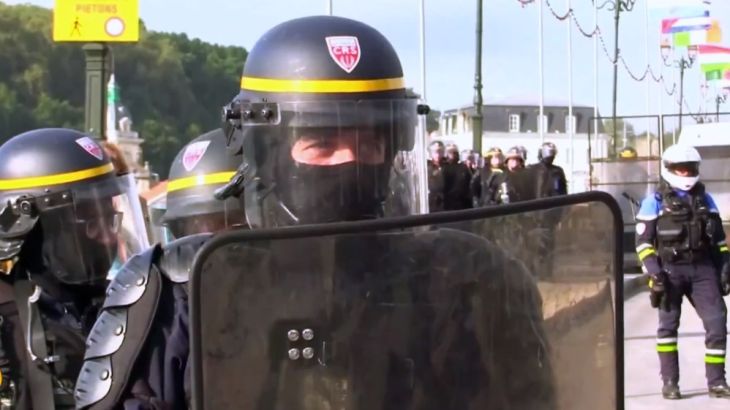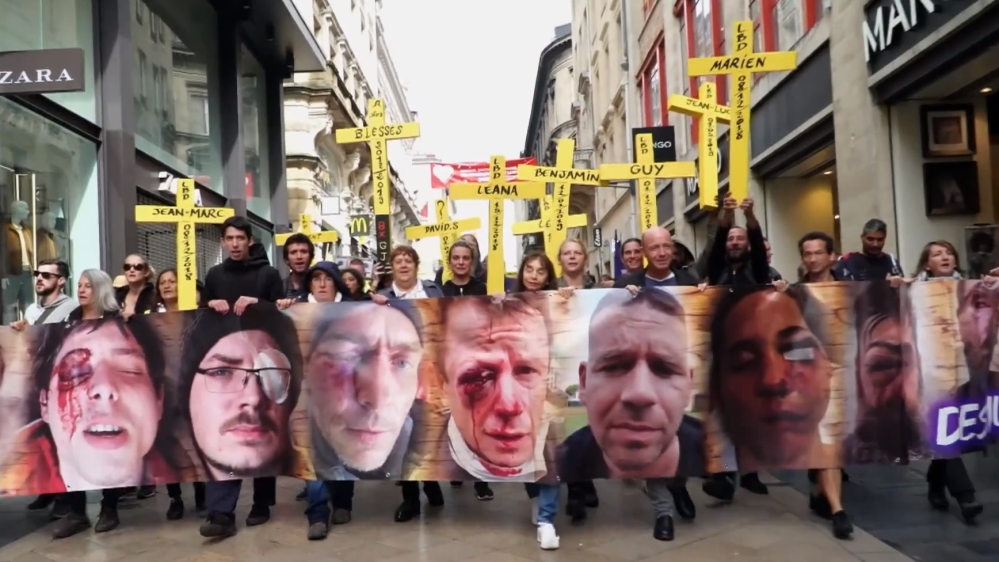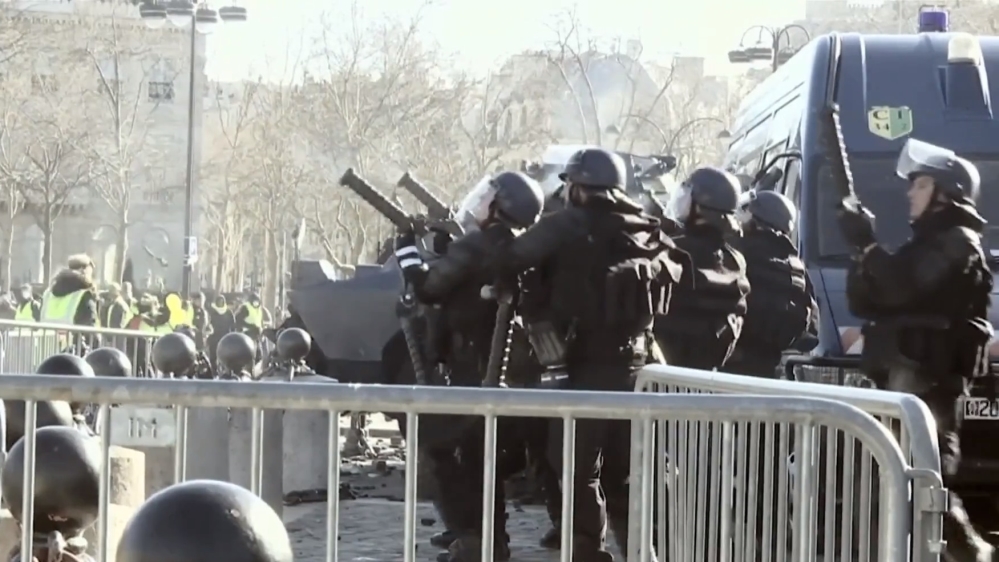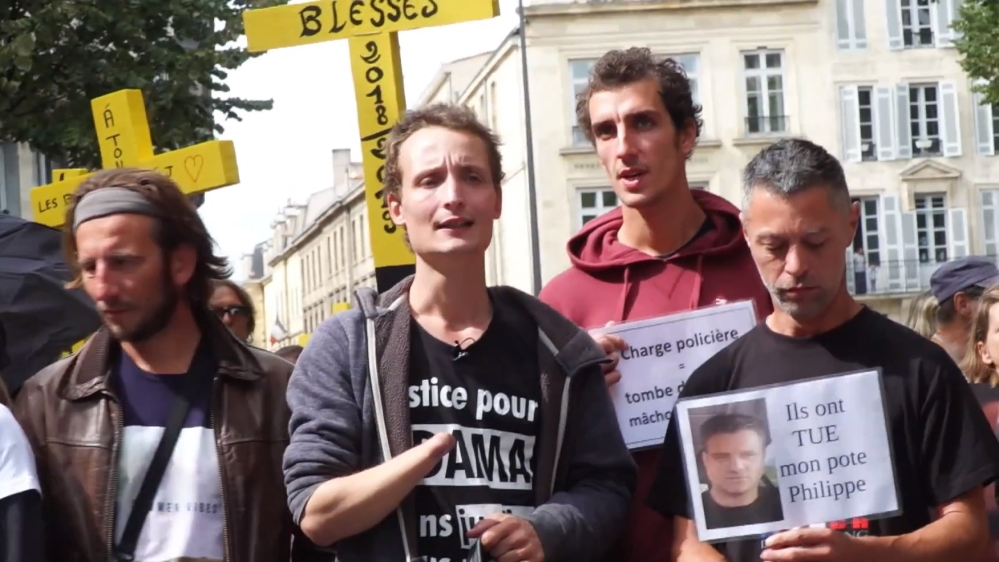
France: Police on Trial
We investigate whether aggressive French policing of demonstrations is stifling dissent and threatening civil liberties.
For well over a year, France’s yellow vest activists have been making full use of their constitutionally enshrined right to protest against the economic policies of President Emmanuel Macron – most recently in support of a trade union standoff with the government over pension reform proposals.
But the often uncompromising response of the authorities during some of those demonstrations – in which thousands of protesters and police officers have been injured – has raised disturbing questions about the appropriate degree of force to use in maintaining public order.
Keep reading
list of 4 itemsKenya’s President Ruto visits US as police deployment to Haiti takes shape
French forces clear New Caledonia roadblocks as official vows to end unrest
Two officers killed in suspected JI attack on Malaysian police station
Juliana Ruhfus has been to investigate claims that increasingly paramilitary-style law enforcement techniques – including the use of riot control weapons that can seriously injure those on the receiving end – are threatening to undermine France’s democratic principles.
FILMMAKER’S VIEW
By Juliana Ruhfus
On Saturday, March 16, 2019, France’s yellow vest protesters were on the streets once more. Over the preceding four months it had been their strategy to protest without permission and in places where the government never tolerated protests such as the world-famous Champs Elysees, lined with expensive shops and near diplomatic and government buildings.
Protests that had been authorised by the government, they said, had failed to get results.

Since their beginning, the yellow vest marches had led to an unprecedented number of injuries: according to the French Interior Ministry, over 2,000 protesters and around 1,600 police had been injured.
For our filming, we spoke to David Breidenstein, a member of the Collective of the Wounded. All of its 22 members had suffered serious injuries at the hands of the police and David had lost an eye. It is well known that the French police have some of the most menacing weapons in Europe and they were using them against the protesters.
“They are there to hurt,” David Breidenstein told us, “and to say ‘Listen, you will not go back to protest.’ That’s why I keep going!”
But it wasn’t that easy to get a handle on the story. Watching the footage of the demonstrations it was clear that some protesters were also violent, not only those on the extreme left and right who had spotted an opportunity to infiltrate the marches and to cause trouble, but also some members of the yellow vests.
As independent journalists, what were we to make of it?

What stood out from the start was President Macron’s failure to acknowledge both the protests themselves, and the reasons why people had taken to the streets. Instead of addressing the crowds, he sent in the police, and by treating the protests as riots it was possible to use a maximum of force.
His stance was considered arrogant and the reaction was one of rage.
As the police met with protesters they used weapons that are far more severe than those of their European counterparts. In Switzerland, where it’s produced, the LBD-40 riot control gun is considered military equipment, but in France, it’s used on civilians.
The French Gli-F4 tear gas grenade contains 25 milligrams of explosives and France is the only country in Europe to use it. Taken together, both weapons resulted in serious injuries, loss of limbs, and loss of eyes. Not only David and the members of the Collective of the Wounded, but also France’s official Human Rights Ombudsman and groups of doctors called for them to be banned, too.
But while the injuries were striking, it was the invisible state violence that stayed with me after we stopped working on this film.
Over the past decade, the French government has passed laws that allow the police to detain people on the mere suspicion that a crime will be committed. The most prominent one, originally conceived to work against criminal groups, is now used against protesters. If instructed by a local police prefect, the police can now detain anyone who carries a white facemask while in the proximity of an unauthorised protest, even though no crime has yet taken place.
We experienced this ourselves in Biarritz during the G7 summit where violent protests were feared. Not only did we witness arrests of protesters during the days of the summit for no other reasons than that suspicious items were found in their baggage but we ourselves had our gas masks and helmets taken from us by the police when we wanted to film an unauthorised protest. No explanation was given at the time (we were later told it was an “error”) but without our kit, our safety was at risk and French colleagues told us that his was no isolated incident.

So, while the G7 looked like a policing success to the outside world – no torched cars, trademark of French protests, and not even broken windows – several international organisations such as Amnesty International and Reporters Without Borders pointed out that democratic freedoms had been trampled on.
But this was not the only right under attack. When we met David Breidenstein and the members of the Collective of the Wounded again we heard that they found it virtually impossible to have the circumstances of their injuries investigated by the authorities.
In France, the police are responsible for investigating themselves and there have long been complaints that this system is not working. All of the injured yellow vests that we met had requested the Inspector General of the French National Police to open an investigation but not one had been successful, sometimes in spite of an astonishing amount of evidence supplied.
To date, around 300 investigations have been launched, a figure that’s likely to be on the low side, and out of those less than a handful have been concluded.
Justice, it seems, is another invisible casualty.
One of the last things we filmed was a protest in Bordeaux organised by Antoine Boudinet who had lost a hand after picking up a Gli-F4 tear gas grenade during a yellow vest march. By now, we had come to understand that the physical injuries displayed by the members of the Collective of the Wounded were only the tip of the iceberg.

Antoine’s speech explored the yellow vests’ perception of violence in France and he took everyone back to the reasons why the protests started in the first place: “They always try to justify their actions by saying that we deserve what happens to us, portraying ourselves as violent people when it’s their violence that’s caused everything that’s happening right now. It’s their social violence, it’s police violence, it’s the violence of justice.”
It was a sentence that resonated with me so much more now that our filming was drawing to a close.
Violence is not always visible and state violence can take the shape of violations of democratic rights. On a small scale, we ourselves had experienced this when our safety helmets and gas masks were taken away by the police who exposed us, internationally accredited journalists, to danger during the course of our work.
Protests may be messy and look bad on TV but they are also a sign of a healthy democracy.